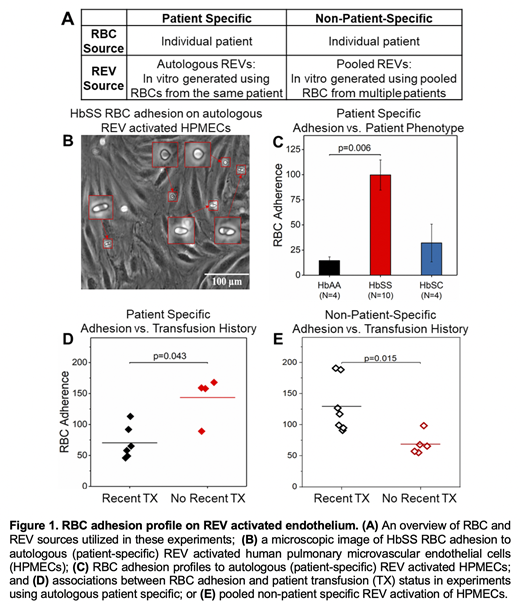Introduction: Sickle cell disease (SCD) is an inherited hemoglobinopathy, in which the mutation of a single amino acid in the adult beta chain results in sickle hemoglobin (HbS). Upon deoxygenation, HbS polymerizes in red blood cells (RBCs) and provokes a complex pathophysiology of acute and chronic organ damage. Sickle RBCs have reduced deformability, increased adhesion to the endothelium, and are prone to hemolysis, which further contributes to endothelial dysfunction. Chronic inflammatory processes as well as hemostatic alterations and thrombotic events are common in SCD. Cumulatively, thromboinflammation plays a significant pathophysiologic role in SCD, contributing to venous thromboembolism, vaso-occlusion, ischemia-reperfusion, and chronic organ damage, which cumulatively lead to increased morbidity, health care utilization, and a reduced life expectancy. Several pathophysiological processes in SCD result in the activation of RBCs and in the release of sub-micron particles called extracellular vesicles (EVs). EVs are composed of a lipid bilayer, transmembrane proteins, and enclosing intracellular remnants, including cytosolic proteins, RNA, and micro-RNA (miRNA). EVs can serve as vehicles for cellular communication, in near and remote proximity, and can reflect the parent cell's activation state. In SCD, RBC-derived EVs (REVs) comprise the most prevalent (>50%) subtype. REVs express surface phosphatidylserine (PS), contain heme and miRNAs, and are capable of promoting blood coagulation and a pro-inflammatory/pro-adhesive endothelial phenotype. Despite the significant potential role of REVs as candidate biomarkers, REV associated proinflammatory effects are often evaluated using animal models, or by assessing white blood cell adhesion, and thus do not reflect the well-known clinical heterogeneity and the abnormal RBC adhesion amongst SCD patients.
Methods: We have developed an in vitro microfluidic assay, the SCD-EV-BioChip, with which to assess RBC adhesion as a biomarker for REV-mediated lung microvascular endothelial dysfunction. The SCD-EV-BioChip contains microfluidic channels lined with human pulmonary microvascular endothelial cells (HPMECs) that are maintained under precise shear stress and oxygen tension at physiologically and clinically relevant levels. HPMECs were incubated with patient-specific or pooled REVs generated in vitro via exposure of RBCs to calcium ionophore (Fig. 1A&B). We assessed RBC adhesion in 4 healthy subjects (HbAA), 10 homozygous SCD patients (HbSS), and 3 patients with HbSC disease for REV proinflammatory effects using HPMCs exposed to patient specific derived REVs.
Results and Discussion: In non-patient-specific testing, adhesion assays were performed on samples from 12 individuals with HbSS, using HPMECs that had been exposed to pooled REVs derived from multiple patients, thus reflecting only patient-specific RBC intrinsic adhesion, rather than patient-specific contribution of RBC derived REVs. Patient specific REV activation of HPMCs (Fig. 1C&D) showed that RBC adhesion was greater in HbSS-containing samples, compared with HbSC or HbAA (Fig. 1B&C). In subjects with HbSS, RBC adhesion to HPMC, activated by patient-specific derived REV, was higher in those without, vs. those with a recent transfusion (non-TX vs. TX, Fig. 1D). However, non-TX samples showed intrinsically less adhesion to HPMECs activated by pooled REVs (Fig. 1E), compared with TX samples. Results suggest a paradoxical association between transfusion history and RBC adhesion in patient specific tests vs. non-patient-specific tests. This association suggests that the minority of RBCs containing HbSS in TX subjects generate fewer or less active patient specific REVs, but that these residual HbSS-RBCs are highly adherent when the endothelium is perturbed by pooled non-patient specific REVs. These data highlight that patient-specific contributions from both REVs and RBCs must be accounted for when describing abnormal RBC adhesion in individuals with SCD.
An:Hemex Health, Inc.: Patents & Royalties. Little:NHLBI: Research Funding; GBT: Membership on an entity's Board of Directors or advisory committees; GBT: Research Funding; Bluebird Bio: Research Funding; BioChip Labs: Patents & Royalties: SCD Biochip (patent, no royalties); Hemex Health, Inc.: Patents & Royalties: Microfluidic electropheresis (patent, no royalties). Gurkan:Dx Now Inc.: Patents & Royalties; Xatek Inc.: Patents & Royalties; BioChip Labs: Patents & Royalties; Hemex Health, Inc.: Consultancy, Current Employment, Patents & Royalties, Research Funding.
Author notes
Asterisk with author names denotes non-ASH members.


This feature is available to Subscribers Only
Sign In or Create an Account Close Modal